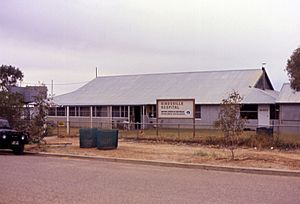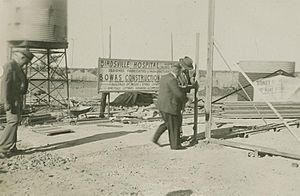Australian Inland Mission Hospital, Birdsville facts for kids
Quick facts for kids Australian Inland Mission Hospital |
|
|---|---|

Australian Inland Mission Hospital, 2007
|
|
| Location | Adelaide Street, Birdsville, Shire of Diamantina, Queensland, Australia |
| Design period | 1940s–1960s (post-World War II) |
| Built | 1952–1953 |
| Official name: Australian Inland Mission Hospital (former) | |
| Type | state heritage (built) |
| Designated | 17 July 2008 |
| Reference no. | 602635 |
| Significant period | 1953–2005 |
| Significant components | hospital |
| Builders | Ben Hargreaves |
| Lua error in Module:Location_map at line 420: attempt to index field 'wikibase' (a nil value). | |
The Australian Inland Mission Hospital is a special old hospital building in Birdsville, Australia. It was built between 1952 and 1953 by Ben Hargreaves. This building is important because it helped people living in remote areas. It is now listed on the Queensland Heritage Register, which means it's protected for its historical value.
A Look Back: The Hospital's Story
The Australian Inland Mission (AIM) Hospital in Birdsville is a single-story building made of prefabricated steel. It was built in 1952-1953. This new hospital replaced an older one that burned down in November 1951.
Early Days in Birdsville
Birdsville is a very remote town in Queensland. It's over 1,600 kilometers (1,000 miles) west of Brisbane. The town started in the 1880s to serve the large cattle stations in the area. It became an important stop for cattle being moved south to markets. Because it was so far away, most early buildings were made from local sandstone.
The Australian Inland Mission Arrives
The Presbyterian Church's Australian Inland Mission (AIM) opened its first bush nursing home in Queensland at Birdsville in 1923. This was in the old Royal Hotel building. The AIM was founded by Rev. Dr. John Flynn. He wanted to create a "mantle of safety" for people in remote parts of Australia.
Connecting the Outback: The Pedal Radio
A big step forward for the AIM was the invention of the pedal radio by Alfred Traeger in 1929. This radio allowed people in remote areas to talk to doctors and others. In August 1929, one of the first pedal radios was set up at the AIM's Birdsville hostel. This made it possible for the new Aerial Medical Service (now the Royal Flying Doctor Service) to help people quickly.
A New Hospital is Built
By 1930, the old Royal Hotel building needed many repairs. The AIM decided to build a new, purpose-built hospital. This new hospital was designed to be a first-aid post. Serious cases could then be flown to bigger towns. The land for the new hospital was bought in 1937. It was a prefabricated building, meaning parts were made in a factory and then put together on site. It opened in December 1937. A separate ward for Aboriginal patients was added before 1951.
The Fire and Rebuilding
On November 10, 1951, the AIM Hospital in Birdsville was destroyed by a fire. It was thought to have started when a kerosene refrigerator exploded. Luckily, no one died. Only the Aboriginal ward was saved.
The local community quickly started raising money for a new hospital. Donations came from all over Australia. The Queensland government also promised to match the money raised. This helped make sure the new hospital could be built.
In February 1952, a new prefabricated steel building was ordered from a factory in Sydney. The building materials traveled over 3,200 kilometers (2,000 miles) by road to Birdsville. The Queensland Governor, John Lavarack, even visited in June 1952 to help set the first corner post.
Ben Hargreaves, who built the 1937 hospital, came out of retirement to build this new one. He was a skilled builder and made much of the hospital's furniture himself. The new hospital cost £15,000 and opened on August 5, 1953. It was a huge community event, with races and a dance. The opening was even filmed for a movie called Diamantina Drama.
How the Hospital Was Designed
The new hospital had a large central room. This room could be used for public gatherings. It also had a dispensary, two wards (one for men, one for women), a wireless room, a large kitchen, bathrooms, and rooms for the nurses.
The company that made the prefabricated parts, Sidney Williams & Co., was well-known. They made steel-framed buildings that were strong, fireproof, and easy to put together. These buildings were perfect for remote areas like Birdsville.
Later Years and Closure
Over time, more buildings were added to the hospital site. These included a laundry, a power plant house, and cottages for elderly bushmen. These cottages were built in 1963.
In the 1970s, the AIM joined with other church missions to form the Uniting Church in Australia Frontier Services. Frontier Services operated the Birdsville AIM Hospital from 1977 until 2005.
The hospital closed in 2005 after serving the community for 52 years. Its work was taken over by the Diamantina Shire Council, which built a new clinic nearby. The old AIM Hospital is now open to the public as a historical display.
What the Hospital Looks Like
The former Australian Inland Mission Hospital is at the eastern end of Adelaide Street in Birdsville. The site includes the main hospital building, the former Aboriginal ward, and water tanks.
The Main Hospital Building
The hospital building is a rectangular shape with a gabled hip roof. It has enclosed verandahs on three sides. It's built with a steel frame and corrugated iron walls. The floors are concrete, mostly covered with linoleum.
The hospital was designed especially for the hot inland climate. The ceilings are well insulated, and there are air vents to keep the roof cool. It also has a cool storage cellar under the kitchen. There are tanks for both rainwater and town water. A communications aerial is on the roof.
You enter the hospital through a covered walkway. Inside, there's a central chapel. On one side are two wards. On the other side are a pantry and a kitchen. The kitchen leads to the large central pavilion. The western and southern verandahs have been enclosed to create bathrooms and storage.
The Aboriginal Ward
The former Aboriginal ward is located behind the main hospital building. It's also made of corrugated iron with a steel frame and a gabled roof. It has an open verandah, two wards, and an enclosed back verandah. The windows have hinged corrugated iron shutters.
Other buildings on the site, like a billiard room and a new Padre Cottage, are newer and not considered part of the original historic hospital.
Why This Place is Important
The former Australian Inland Mission Hospital in Birdsville is listed on the Queensland Heritage Register for several reasons:
- Showing Queensland's History: It shows how important the AIM was in providing medical care to remote parts of Queensland. It was rebuilt after a fire, showing how much the community needed it.
- A Rare Example: This hospital is a rare example of the AIM's work. Only two of these special hospitals built in Queensland still exist today.
- Typical AIM Hospital: It shows what a typical AIM hospital was like. It had wards, a dispensary, kitchen, bathrooms, and nurse's quarters. It also had separate buildings like the Aboriginal ward and accommodation for elderly people. It's also a good example of a prefabricated building made by Sidney Williams & Co.
- Strong Community Connection: This hospital was vital for the people of Birdsville and the surrounding areas. The community raised money from all over Australia to rebuild it. Its opening in 1953 was a huge event, showing how much it meant to everyone.
- Link to Important People: It has a special connection to the Presbyterian Church's Australian Inland Mission and its founder, Rev. Dr. John Flynn. For 52 years, this hospital worked with the Royal Flying Doctor Service to provide medical help to remote communities.


